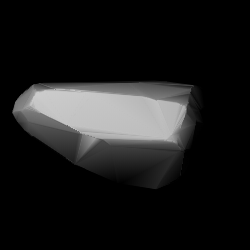 3D convex shape model of 136 Austria 3D convex shape model of 136 Austria | |
| Discovery | |
|---|---|
| Discovered by | Johann Palisa |
| Discovery site | Austrian Naval Obs. |
| Discovery date | 18 March 1874 |
| Designations | |
| MPC designation | (136) Austria |
| Named after | Austria |
| Alternative designations | A874 FA; 1950 HT |
| Minor planet category | main-belt · (inner) background |
| Orbital characteristics | |
| Epoch 23 March 2018 (JD 2458200.5) | |
| Uncertainty parameter 0 | |
| Observation arc | 141.11 yr (51,539 d) |
| Aphelion | 2.4812 AU |
| Perihelion | 2.0927 AU |
| Semi-major axis | 2.2869 AU |
| Eccentricity | 0.0849 |
| Orbital period (sidereal) | 3.46 yr (1,263 d) |
| Mean anomaly | 102.82° |
| Mean motion | 0° 17 6 / day |
| Inclination | 9.5788° |
| Longitude of ascending node | 186.46° |
| Time of perihelion | 2024-Feb-24 |
| Argument of perihelion | 132.95° |
| Physical characteristics | |
| Mean diameter | 40.14±1.0 km 40.14 km |
| Mass | 6.8×10 kg |
| Synodic rotation period | 11.4969 h (0.47904 d) |
| Geometric albedo | 0.1459±0.007 0.1459 |
| Spectral type | M |
| Absolute magnitude (H) | 9.69 |
136 Austria is a main-belt asteroid that was found by the prolific asteroid discoverer Johann Palisa on 18 March 1874, from the Austrian Naval Observatory in Pola, Istria. It was his first asteroid discovery and was given the Latin name of his homeland.
Based upon its spectrum, it is classified as an M-type spectrum, although Clark et al. (1994) suggest it may be more like an S-type asteroid. It shows almost no absorption features in the near infrared, which may indicate an iron or enstatite chondrite surface composition. A weak hydration feature was detected in 2006.
Photometric observations of this asteroid at the European Southern Observatory in 1981 gave a light curve with a period of 11.5 ± 0.1 hours and a brightness variation of 0.40 in magnitude. As of 2013, the estimated rotation period is 11.4969 hours.
References
- ^ "136 Austria". Minor Planet Center. Retrieved 29 May 2018.
- ^ "JPL Small-Body Database Browser: 136 Austria" (2018-02-26 last obs.). Jet Propulsion Laboratory. Retrieved 29 May 2018.
- "Asteroid 136 Austria". Small Bodies Data Ferret. Retrieved 29 May 2018.
- ^ Schober, H. J. (January 1983), "Rotation periods and lightcurves of the asteroids 136 Austria and 238 Hypatia", Astronomy and Astrophysics, vol. 117, no. 2, pp. 362–364, Bibcode:1983A&A...117..362S.
- Albrecht, R.; et al. (July 2001), "Early asteroid research in Austria", Planetary and Space Science, vol. 49, no. 8, pp. 777–779, Bibcode:2001P&SS...49..777A, doi:10.1016/S0032-0633(01)00027-7.
- Clark, B. E.; et al. (March 1994), "Infrared Spectral Observations of Smaller (50 km) Main Belt S, K, and M Type Asteroids", Abstracts of the 25th Lunar and Planetary Science Conference, held in Houston, TX, 14–18 March 1994, pp. 265–266, Bibcode:1994LPI....25..265C.
- Hardersen, Paul S.; Gaffey, Michael J.; Abell, Paul A. (January 1983), "Near-IR spectral evidence for the presence of iron-poor orthopyroxenes on the surfaces of six M-type asteroids", Icarus, vol. 175, no. 1, pp. 141–158, Bibcode:2005Icar..175..141H, doi:10.1016/j.icarus.2004.10.017.
- Behrend, Raoul, Courbes de rotation d'astéroïdes et de comètes (in French), Observatoire de Genève, retrieved 30 March 2013
External links
- 136 Austria at AstDyS-2, Asteroids—Dynamic Site
- 136 Austria at the JPL Small-Body Database

| Minor planets navigator | |
|---|---|
| Small Solar System bodies | |||||||
|---|---|---|---|---|---|---|---|
| Minor planets |
| ||||||
| Comets | |||||||
| Other | |||||||
This article about an asteroid native to the asteroid belt is a stub. You can help Misplaced Pages by expanding it. |